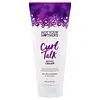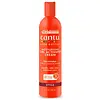What's inside
What's inside
 Benefits
Benefits

 Concerns
Concerns

 Ingredients Side-by-side
Ingredients Side-by-side

Water
Skin ConditioningPolyacrylamide
C13-14 Isoparaffin
EmollientShea Butter Ethyl Esters
EmollientPolyquaternium-10
Lactobacillus/Tomato Fruit Ferment Extract
Skin ConditioningOryza Sativa Extract
AbsorbentKeratin Amino Acids
Skin ConditioningLeuconostoc/Radish Root Ferment Filtrate
AntimicrobialAcyl Coenzyme A Desaturase
Skin ConditioningLaureth-7
EmulsifyingPg-Hydroxyethylcellulose Cocodimonium Chloride
Parfum
MaskingDisodium EDTA
Phenoxyethanol
PreservativeEthylhexylglycerin
Skin ConditioningWater, Polyacrylamide, C13-14 Isoparaffin, Shea Butter Ethyl Esters, Polyquaternium-10, Lactobacillus/Tomato Fruit Ferment Extract, Oryza Sativa Extract, Keratin Amino Acids, Leuconostoc/Radish Root Ferment Filtrate, Acyl Coenzyme A Desaturase, Laureth-7, Pg-Hydroxyethylcellulose Cocodimonium Chloride, Parfum, Disodium EDTA, Phenoxyethanol, Ethylhexylglycerin
Water
Skin ConditioningGlycerin
HumectantPropanediol
SolventCetearyl Alcohol
EmollientButyrospermum Parkii Butter
Skin ConditioningParfum
MaskingStearyl Alcohol
EmollientCetyl Alcohol
EmollientPolyquaternium-10
Cocos Nucifera Oil
MaskingBiotin
AntiseborrhoeicFolic Acid
Skin ConditioningNiacin
SmoothingPantothenic Acid
Skin ConditioningCyanocobalamin
Skin ConditioningPyridoxine Hcl
Skin ConditioningRiboflavin
Cosmetic ColorantThiamine Hcl
MaskingSimmondsia Chinensis Seed Oil
EmollientOlea Europaea Fruit Oil
MaskingArgania Spinosa Kernel Oil
EmollientDaucus Carota Sativa Seed Oil
EmollientMacadamia Ternifolia Seed Oil
EmollientMangifera Indica Seed Butter
Skin ConditioningPrunus Amygdalus Dulcis Oil
Skin ConditioningVitis Vinifera Seed Oil
EmollientAloe Barbadensis Leaf Juice
Skin ConditioningLonicera Caprifolium Flower Extract
PerfumingMacrocystis Pyrifera Extract
Skin ConditioningSalvia Officinalis Leaf Extract
CleansingUrtica Dioica Leaf Extract
Skin ConditioningHydrolyzed Silk
HumectantPersea Gratissima Oil
Skin ConditioningBehentrimonium Methosulfate
Phenoxyethanol
PreservativePolysorbate 60
EmulsifyingPolyquaternium-11
Benzyl Benzoate
AntimicrobialPolyquaternium-39
Cetrimonium Chloride
AntimicrobialEthylhexylglycerin
Skin ConditioningCoumarin
PerfumingSilk Amino Acids
HumectantHexyl Cinnamal
PerfumingLeuconostoc/Radish Root Ferment Filtrate
AntimicrobialBenzyl Salicylate
PerfumingBenzyl Alcohol
PerfumingPotassium Sorbate
PreservativeSodium Benzoate
MaskingCitric Acid
BufferingSodium Sulfite
PreservativeWater, Glycerin, Propanediol, Cetearyl Alcohol, Butyrospermum Parkii Butter, Parfum, Stearyl Alcohol, Cetyl Alcohol, Polyquaternium-10, Cocos Nucifera Oil, Biotin, Folic Acid, Niacin, Pantothenic Acid, Cyanocobalamin, Pyridoxine Hcl, Riboflavin, Thiamine Hcl, Simmondsia Chinensis Seed Oil, Olea Europaea Fruit Oil, Argania Spinosa Kernel Oil, Daucus Carota Sativa Seed Oil, Macadamia Ternifolia Seed Oil, Mangifera Indica Seed Butter, Prunus Amygdalus Dulcis Oil, Vitis Vinifera Seed Oil, Aloe Barbadensis Leaf Juice, Lonicera Caprifolium Flower Extract, Macrocystis Pyrifera Extract, Salvia Officinalis Leaf Extract, Urtica Dioica Leaf Extract, Hydrolyzed Silk, Persea Gratissima Oil, Behentrimonium Methosulfate, Phenoxyethanol, Polysorbate 60, Polyquaternium-11, Benzyl Benzoate, Polyquaternium-39, Cetrimonium Chloride, Ethylhexylglycerin, Coumarin, Silk Amino Acids, Hexyl Cinnamal, Leuconostoc/Radish Root Ferment Filtrate, Benzyl Salicylate, Benzyl Alcohol, Potassium Sorbate, Sodium Benzoate, Citric Acid, Sodium Sulfite
Ingredients Explained
These ingredients are found in both products.
Ingredients higher up in an ingredient list are typically present in a larger amount.
Ethylhexylglycerin (we can't pronounce this either) is commonly used as a preservative and skin softener. It is derived from glyceryl.
You might see Ethylhexylglycerin often paired with other preservatives such as phenoxyethanol. Ethylhexylglycerin has been found to increase the effectiveness of these other preservatives.
Leuconostoc/Radish Root Ferment Filtrate is a natural preservative. It comes from fermenting radish roots with a bacteria called leuconostoc.
Leuconostoc comes from lactic acid.
This ingredient has antimicrobial properties and helps prevent the growth of bacteria in a product.
Leuconostoc is used to make the traditional Korean side-dish, kimchi. It is also used to make sourdough bread (both incredibly yummy foods).
Learn more about Leuconostoc/Radish Root Ferment FiltrateParfum is a catch-all term for an ingredient or more that is used to give a scent to products.
Also called "fragrance", this ingredient can be a blend of hundreds of chemicals or plant oils. This means every product with "fragrance" or "parfum" in the ingredients list is a different mixture.
For instance, Habanolide is a proprietary trade name for a specific aroma chemical. When used as a fragrance ingredient in cosmetics, most aroma chemicals fall under the broad labeling category of “FRAGRANCE” or “PARFUM” according to EU and US regulations.
The term 'parfum' or 'fragrance' is not regulated in many countries. In many cases, it is up to the brand to define this term.
For instance, many brands choose to label themselves as "fragrance-free" because they are not using synthetic fragrances. However, their products may still contain ingredients such as essential oils that are considered a fragrance by INCI standards.
One example is Calendula flower extract. Calendula is an essential oil that still imparts a scent or 'fragrance'.
Depending on the blend, the ingredients in the mixture can cause allergies and sensitivities on the skin. Some ingredients that are known EU allergens include linalool and citronellol.
Parfum can also be used to mask or cover an unpleasant scent.
The bottom line is: not all fragrances/parfum/ingredients are created equally. If you are worried about fragrances, we recommend taking a closer look at an ingredient. And of course, we always recommend speaking with a professional.
Learn more about ParfumPhenoxyethanol is a preservative that has germicide, antimicrobial, and aromatic properties. Studies show that phenoxyethanol can prevent microbial growth. By itself, it has a scent that is similar to that of a rose.
It's often used in formulations along with Caprylyl Glycol to preserve the shelf life of products.
Polyquaternium-10 is an ammonium salt of hydroxyethylcellulose. It is a white and granular powder used as a film-former and anti-static agent.
This ingredient is commonly found in hair conditioning products. According to a manufacturer, its positive charge makes it great for absorbing hair proteins. The manufacturer also states this ingredient helps with curl retention.
For haircare friends: this ingredient is not a silicone.
Learn more about Polyquaternium-10Water. It's the most common cosmetic ingredient of all. You'll usually see it at the top of ingredient lists, meaning that it makes up the largest part of the product.
So why is it so popular? Water most often acts as a solvent - this means that it helps dissolve other ingredients into the formulation.
You'll also recognize water as that liquid we all need to stay alive. If you see this, drink a glass of water. Stay hydrated!
Learn more about Water